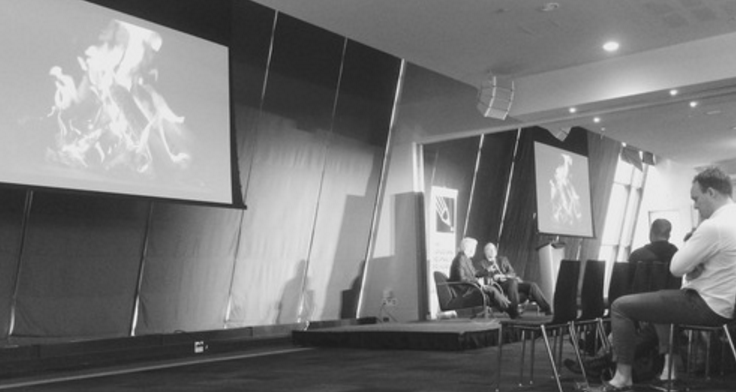Globe and Mail Editor-in-Chief: “Sloppy standards” is where they found issues with Wente
David Walmsley addresses questions from Canadaland and J-Source during a CJF talk in Toronto on May 5.
By H.G. Watson, Associate Editor
Globe and Mail Editor-in-Chief David Walmsley said that it was “sloppy standards” where they found issues with columnist Margaret Wente.
Walmsley was at the Toronto Board of Trade in downtown Toronto on May 5 to interview Google Senior Director of News Richard Gingras—and, for a majority of the evening, they discussed how Google and journalism might work together.
But, given the repeated plagiarism allegations against Wente and Walmsley’s relative silence on the subject—he gave a statement in Globe and Mail Public Editor Sylvia Stead’s Apr. 25 column in response to the allegations—it was inevitable that someone would ask about them.
Jane Lytvynenko, Canadaland editor and reporter, approached the microphones during audience Q&A period and asked: “David, your first question tonight was why should we trust [Google]. Given your continued silence and as far as the public can tell inaction on the growing allegations of plagiarism against Margaret Wente, one of your columnists, how can the Globe and Mail’s readers trust you?”\
Sooo, @CANADALAND's @JaneLytv had a question for David Walmsley pic.twitter.com/xXr9zK6cyy
— H.G. Watson (@HG_Watson) May 5, 2016
As promised, he spoke to Lytvynenko after the talk.
https://twitter.com/JaneLytv/status/728374597977030657
https://twitter.com/JaneLytv/status/728374875732230144
Walmsley expanded on those thoughts in an interview with J-Source.
“Where we found fault with her was sloppy standards,” he said. “It wasn’t to the standard we expected so we apologized, because there was a failure to attribute to a story that was subsequently linked to in the piece.”
Walmsley pointed out that Jesse Ausubel, the author of one of the pieces that Wente was alleged to have plagiarized from, told the Toronto Star that the link in the story brought people back to the original source. “I think on the test of both what we looked at when we received the complaint and listening to the individual who presumably would have had the most concern that it is plagiarism, it wasn’t plagiarism.”
On Apr. 30, after the allegations had broken, Wente’s column was absent, replaced with a note.
#Wente Today on F9: pic.twitter.com/HkjqbfXACl
— Janice Neil (she/her) (@JaniceJourno) April 30, 2016
According to Walmsley, she is on pre-planned vacation that had nothing to do with the allegations and will be returning next week.
Walmsley also reiterated what was published in Stead’s column: the opinion editors would work with her to ensure this wouldn’t happen again. “There is increased awareness of the potential for problems, be it sloppiness and indeed, as we found in 2012, of plagiarism.” He did however tell Lytvynenko that he would not discuss repercussions.
“Where we have a problem that people are still feeling that it is plagiarism,” he said. “I think that’s partly because we don’t have an industry accepted standard of what plagiarism is in the news business.”
The Canadian Press Style Book makes no mention of plagiarism, though it does emphasize the need for attribution. “Absolute accuracy and precise attribution rank ahead of speed in handling breaking news,” it said in the section on working journalists. And regarding information sourced online:
The same copyright rules apply to material from websites as print publications. Material must be fully credited when paraphrased and enclosed in quotation marks when carried word for word. Guard against accidentally cutting and pasting words that are not your own into copy with proper attribution.
The Canadian Association of Journalism does include guidelines around plagiarism in their Ethics Guidelines:
While news and ideas are there for the taking, the words used to convey them are not. If we borrow a story or even a paragraph from another source we either credit the source or rewrite it before publication or broadcast. Using another’s analysis or interpretation may constitute plagiarism, even if the words are rewritten, unless it is attributed.
The National News Media Council, of which the Globe and Mail is a member, does not have its own code of practice but will consider the code of the media organization in question if there is a complaint.
The Globe and Mail has their own Editorial Code of Conduct, which has this to say about plagiarism:
It is unacceptable to represent another person’s work as your own. Excerpts from other people’s prose must be attributed so as to avoid even a suspicion of copying. Although it is sometimes reasonable to adopt a few words without attribution (in a technical definition, for example), careful judgment is required. When in doubt, consult a senior editor. Any extensive unacknowledged use of another’s words, structure or ideas may constitute plagiarism. Exception: Background from previously published Globe staff and news-service items may be recycled, verbatim or otherwise, without credit, although you should not borrow someone’s distinctive prose style in doing so.
Walmsley suggested that newspapers could potentially use a computer program to detect plagiarism. “Is there a coding we could write as an industry that would allow our work to be looked at pre-publication?” Many colleges and universities use Turnitin, a program similar to what Wamsley described, to find plagiarism in academic work.
“We’re in a hurry. We are publishing a lot more than an academic environment,” he added. “We’re not trying to do the footnotes and be absolutely everything to every person as well. So how do you find something that would satisfy…what newsrooms have to face every day.”
A guerilla version of that code already exists. On May 5, Canadaland wrote about the results of a bot created by an anonymous source made to check articles Wente links to in her stories for similar phrases. It found six examples of rewritten copy.
Walmsley said that for now, he’s open to any suggestion for how to improve standards in the newsroom. “If someone can come up with a) an agreed standard and b) how you actually place that pre-publication, I’m all ears.”
H.G. Watson can be reached at hgwatson@j-source.ca or on Twitter.
H.G. Watson was J-Source's managing editor from 2015 to 2018. She is a journalist based in Toronto. You can learn more about her at hgwatson.com.



